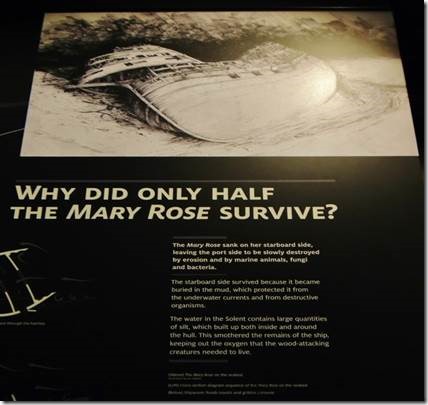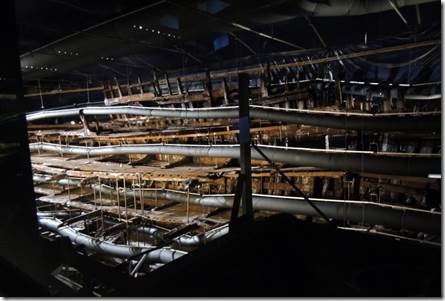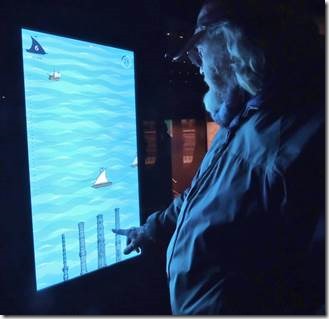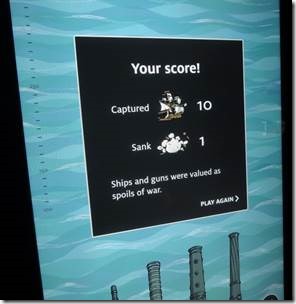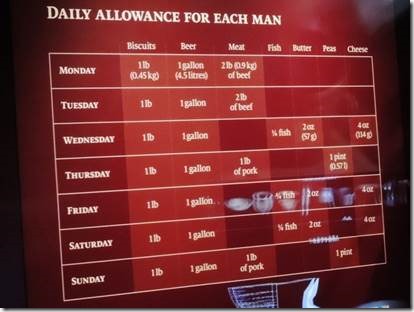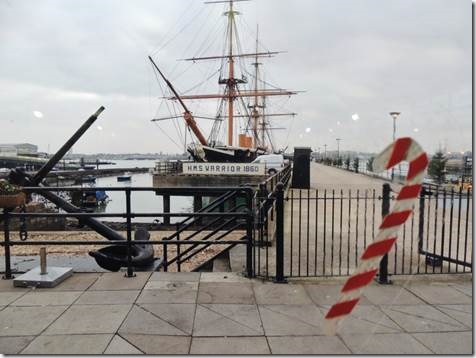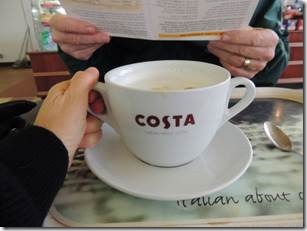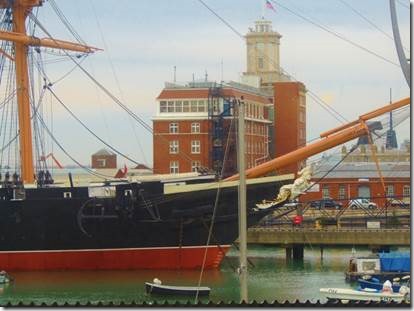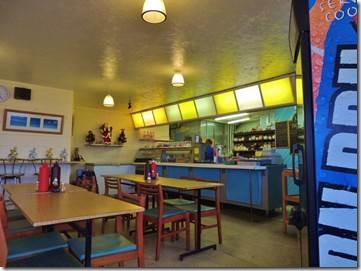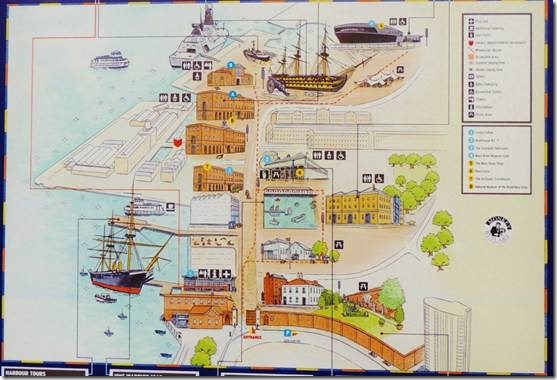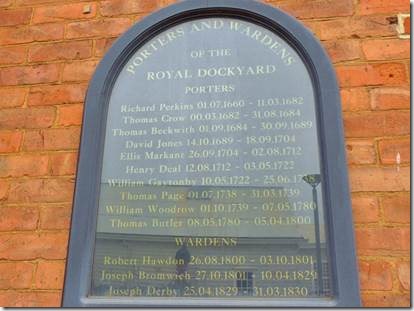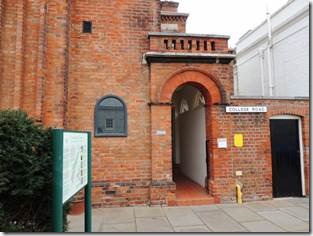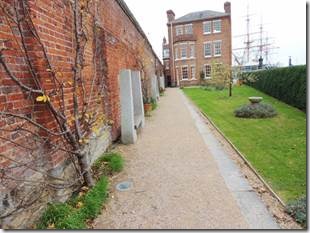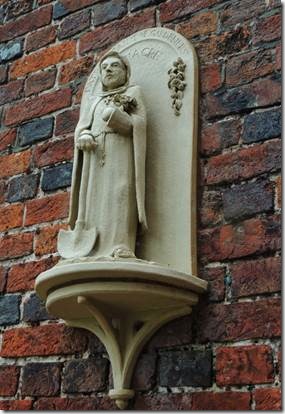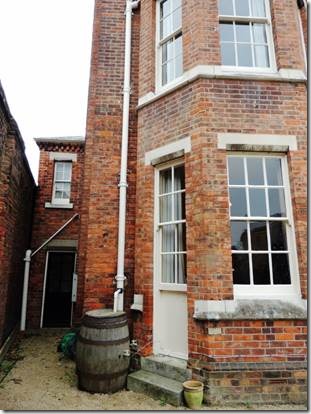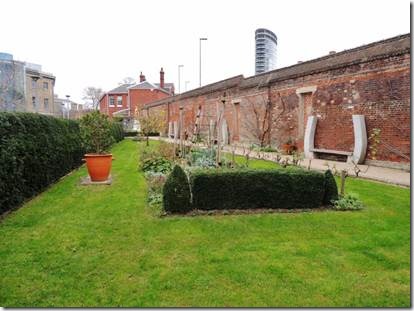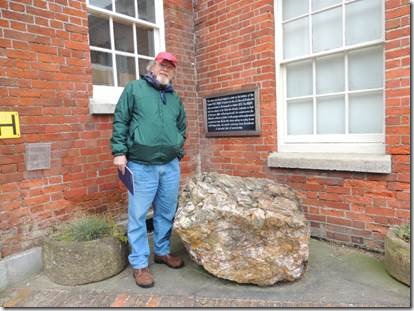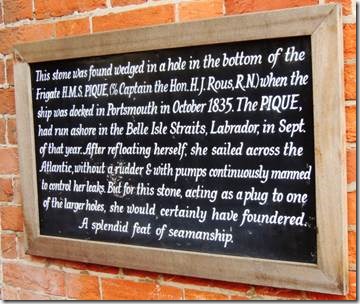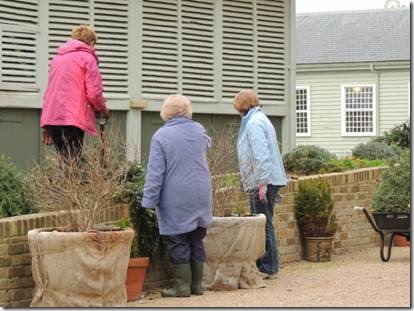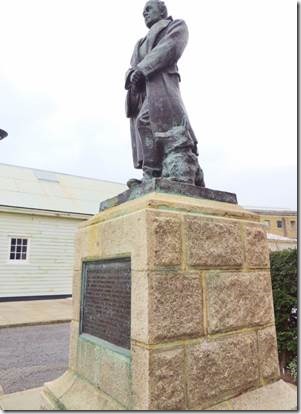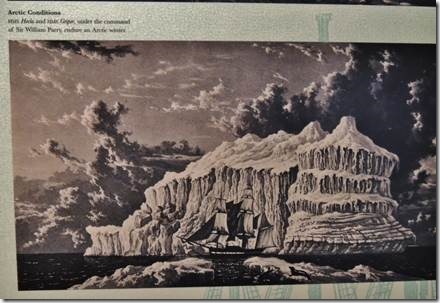Cheers,
Saturday I joined a walking tour in Bloomsbury based on several “Sketches by Boz” and luckily I’d actually read one of them that morning. Sunday Sue and Ed Kelly, Sue Ross and I went mudlarking on the Thames looking for treasures. We had no license so we were only allowed to pick up what was visible and not “dig” for anything. It was lots of fun and I’ll write about it when I’ve finished with Portsmouth. That may not be for a bit as a cruising pal is coming to visit for a few days so we’ll be out and about.
In the meantime I hope all of you can avoid as much of the bad, cold weather as you can. Ours has actually been lovely the past several days and hopefully will continue while Valerie is here visiting.
Ru
During our visit to Portsmouth we visited the HMS Victory, The HMS Warrior and The Mary Rose Museum. There were also buildings dedicated to the Royal Navy and Lord Nelson. But my favorite was the Antiques Storehouse where I bought an old black and white postcard showing Tower Bridge and the Tower of London taken from The Monument. I’ll have to compare it to the photos I took from up top or I might have to climb up again to check how different the view is today. I’m not actually sure of the postcard’s date and will have to see if I can find that out.
“The largest antiques centre on the South Coast. Situated in Storehouse 9, you will find 6,000 sq feet of stunning and quirky antiques, art and collectables. We always exhibit:
•400 paintings and etchings from the 17th to 20th Century
• Classic furniture covering early English oak to Victorian
•Ceramics and glassware such as vintage Royal Doulton, Lalique, Beswick, Goss and Staffordshire
•Militaria including antique swords, black powder weapons, cannons, de-activated guns, badges and uniforms
•Maritime items featuring original ship binnacles, telegraphs, wheels, model ships and Titanic artefacts
Plus jewellery, antiquities, early toys, bronzes and so much more!”
http://www.historicdockyard.co.uk/dockyard-shopping.php
The Mary Rose
The Mary Rose had a tragic ending but was ultimately half saved by the mud she sank into.
“The Mary Rose is a Tudor ship, built in 1510.
In service for 34 years. Sank in 1545. Discovered in 1971.
Raised in 1982. Now in the final stages of conservation, she takes her place in a stunning and unique museum” http://www.maryrose.org/
|
http://www.maryrose.org/ explains why she sank in the first place: Human Error, The Winds, The French, or Oveloading are all offered as possible explanations. Remains of the Mary Rose |
|
A touch screen test to see how many ships you could capture rather than sink. On our first tries Randal and I each sank a bunch but only captured 4 ships. On his second attempt Randal captured 10! The point was to capture the ship as a spoil of war. |
|
Mary Rose menu No meat on Friday was interesting to me as England by then was a Protestant country under Henry VIII. (But that’s a whole other long complicated issue I’m not getting into here.) “Fine pewter dishes, plates, tankards and spoons were found on the wreck, which were probably used by the officers. However, the site also contained lots of wooden bowls, dishes, plates and tankards, which are an extremely important find as these kinds of everyday domestic objects were normally just thrown away rather than kept for posterity. In the galley, down in the hold just in front of the step for the main mast, were two massive brick ovens. The crew’s food was cooked here in two large cauldrons supported on iron bars over a fire box. Smaller bronze, iron and ceramic cooking pots were also found nearby. The excavation also found casks containing meat bones, both cattle and pig. It looks as if the animals were butchered to meet certain standards – for instance, there were no marrow bones as presumably they would have gone off more quickly than other bones. The food remains were analysed early on in the excavation and give historians an invaluable insight into how much food was needed to run a ship like the Mary Rose. The findings have enabled ‘experimental archaeology’, where experts recreate the cooking facilities and the type and variety of meals that might have been on the Mary Rose. “ |
|
http://www.hmswarrior.org/ seen from the café After our very chilly visit on the HMS Warrior we shared this giganto cut of caramel latte. There was no organized tour so we just wandered around..no so very interesting to me. HISTORY Warrior was designed and built in response to an aggressive French shipbuilding programme which saw the introduction of the first iron-clad warship La Gloire designed by the brilliant naval architect Stanislas Charles Henri Dupuy de Lome. Determined to see off this challenge to the supremacy of the Royal Navy the then First Lord of the Admiralty, Sir John Somerset Pakington, determined to build a ship so superior in terms of quality, speed, size, armament and armour that it would be inconceivable to France that she could take Britain on in a sea battle. When commissioned by Captain the Hon. Arthur Auckland Leopold Pedro Cochrane, on August 1st 1861, Warrior was the largest warship in the world, at 9,210 tons displacement she was fully 60% larger than La Gloire. The ship underwent minor modifications after a sea trial. In June 1862, she started active service in the Channel Squadron, patrolling coastal waters and sailing to Lisbon and Gibraltar. Having introduced a revolution in naval architecture, by 1864 Warrior was superseded by faster designs, with bigger guns and thicker armour. By 1871 she was no longer regarded as the crack ship she had once been, and her roles were downgraded to Coastguard and reserve services. In May of 1883 her fore and main masts were found to be rotten, and not considered worth the cost of repair, Warrior was placed in the reserve, eventually converted to a floating school for the Navy and re-named Vernon III in 1904. Put up for sale as scrap in 1924, no buyer could be found, and so, in March 1929 she left Portsmouth to be taken to Pembroke Dock and converted into a floating oil pontoon, re-named again as Oil Fuel Hulk C77. By 1978, she was the only surviving example of the ‘Black Battlefleet’ – the 45 iron hulls built for the Royal Navy between 1861 and 1877. |
|
Our view from breakfast at the bus/train station Café! They do great eggs, toast and tea just down the street from the Dockyards. You can see some of the Warrior and the Dockyard Buildings. You can also see a flag on the top of the photo. It’s an American flag which is flown out of courtesy for the American Nuclear Sub, the Missouri which was in port for a visit. More about that next email with the photos from our short harbor tour. |
|
By our second day we were regulars and by the third morning….. |
|
Layout of the Historic Dockyards The Mary Rose Museum is the dark building up in the right hand corner and the Victory is just near-by. The Warrior is near the park entrance as is the Porter’s Garden in the lower right. |
|
The porters (very different from what we think of in the US as porters.) Two porters lived in the Porter’s Lodge from 1739-1800, William Woodrow (1739-1780) and Thomas Butler (1780-1800). The porter had three functions. He guarded dockyard boundaries and property and marked working hours by ringing the muster bell and closing the gate against latecomers. To prevent excessive theft of timber, ‘chips’, he allowed ‘no Person to pass out of the Dock Gates with great Coats, large Trousers or any other outer dress that can conceal stores of any kind.’ He also sold beer to the men ‘to enable them the better to carry on their labour and not to distemper them’. The Porter’s life is revealed through his job and outside activities. In 1753, described as a ‘Gentleman’, Woodrow was one of the original pew owners of St George’s Chapel, owning one of the larger pews on the ground floor costing £30. He was the public face of the dockyard, the daily interface between the inside and outside communities. |
|
The Porter’s Lodge The Porter’s Lodge was built in 1708 and is the Dockyard’s oldest surviving building, but an earlier Porter’s watch house stood at the gate in 1698. Other dockyard officers, whose gardens survive, lived in the Commissioner’s house and Long and Short Rows. The Friends of the Porter’s Garden For the millennial ‘Renaissance of Portsmouth Harbour’, in 1998 Portsmouth Naval Base Property Trust commissioned landscape architects Camlin Lonsdale to design a new garden on the site of the former Porter’s garden. During the twentieth century the site had been used for police cells, the Police Superintendent’s Office and an air raid shelter, so it was an architectural confusion. Hampshire Gardens Trust and local residents were consulted. In Spring 2000 a Friends’ committee was set up. |
|
St Fiacre, Patron Saint of Gardeners….catching rain water into a barrel equiped with spiggots. |
|
The garden wall with the police cells buiding at the far end. “The dockyard wall – the garden wall – was built in 1711, so that ‘Ill disposed people inclineing to Purloine, are shut out from doing hurt from the Land’. It also defined the boundary of the Porter’s garden. The gate provided the setting for many embezzlements and a dramatic labour dispute in 1743. It was also used to publish regulations and invite tenders for dockyard contracts and outside projects, such as St George’s Chapel, built in 1753 by dockyard shipwrights and house carpenters.” |
|
Believe it or not….. |
|
Friends of the Porter’s Garden “The Friends of the Porter’s Garden were established in 2001 to care for a new garden laid out on the site of the former garden belonging to the Porter’s Lodge (1708), the oldest building in the Dockyard. Their planting schemes use the kind of plants and flowers which would have been found in an 18th century garden. As well as tending the garden all year round, the Friends raise funds by holding a summer garden party, by taking stalls at the annual Dockyard Festival of Christmas and by selling plants along with jams and chutneys made from organic produce grown in their own gardens or in the Porter’s Garden. Each year they also arrange a series of visits to other historic gardens. In 2009 the garden was extended to include the area beside Boathouse 6. The new Raised Garden is of minimalist style comprising four walnut trees, a raised bed within the retaining wall alongside the slipway, elegant swathes of Bredon gravel and new granite steps. Designed by the Trust’s architectural Trustee, Sir Colin Stansfield Smith CBE, the Raised Garden was formally opened by Mike Hall, Chairman of Hampshire Gardens Trust.” http://www.pnbpropertytrust.org/index.asp?upid=23&msid=5 |
|
Antarctic Explorer Robert Scott Adjacent to Porter’s Lodge is a statue of Antarctic explorer Robert Scott, commissioned and sculptured by his widow. The statue was previously in Long Row in the working Naval Base http://www.historicdockyard.co.uk/ “Edith Agnes) Kathleen Scott (née Bruce, later Lady Kennet) (1878-1947), Sculptor; former wife of Robert Falcon Scott and wife of 1st Baron Kennet Sitter in 15 portraits Artist of 3 portraits Kathleen Scott achieved distinction as a traditional sculptor working in clay from life and during the 1930s her portraits were much in demand. She studied at the Slade School of Fine Art, Atelier Colarossi in Paris, and with Rodin. In 1908 she married the Polar explorer Robert Falcon Scott and was widowed four years later. By then she had an established career as a sculptor. Her sitters included Shaw, Lloyd George, Yeats, Galsworthy and Lawrence. “The "absolute hell" endured a century ago by the youngest member of Scott of the Antarctic’s team on the first British expedition to reach the South Pole has been revealed in 27 letters to his mother that have newly come to light. The correspondence by Apsley Cherry-Garrard describes his torment both on the expedition and on finding the frozen bodies of his doomed companions, his subsequent physical and mental breakdown, and the team’s acute fear of being perceived as failures back home because their Norwegian rival, Roald Amundsen, had reached the South Pole a month before them. Led by Captain Robert Falcon Scott, the Terra Nova team and its feats evoke a heroic age of polar exploration. The letters cover the whole span of the expedition, from its departure in June 1910 to the tragic return of the survivors to New Zealand in February 1913.” http://www.theguardian.com/ The entire article is worth reading. |
|
The Navy wasn’t just about battles; it was also about exploration something I’d not thought about. William Edward Parry’s expeditions, 1819–25 Ships Hecla, Griper, Fury Navigated Lancaster Sound and reached as far as Melville Island – penetrated further west than any previous expedition Demonstrated that one could effectively winter far north in the Arctic. The race to the South Pole http://www.rmg.co.uk/ This site, part of the Royal Museums of Greenwich (where we intend to visit) tells the story of the British exploration of the Antarctic. |

